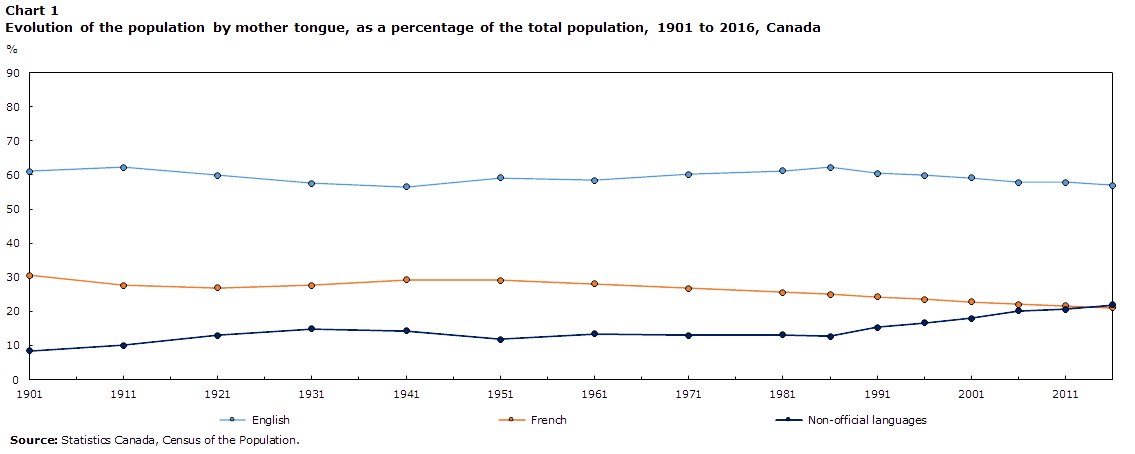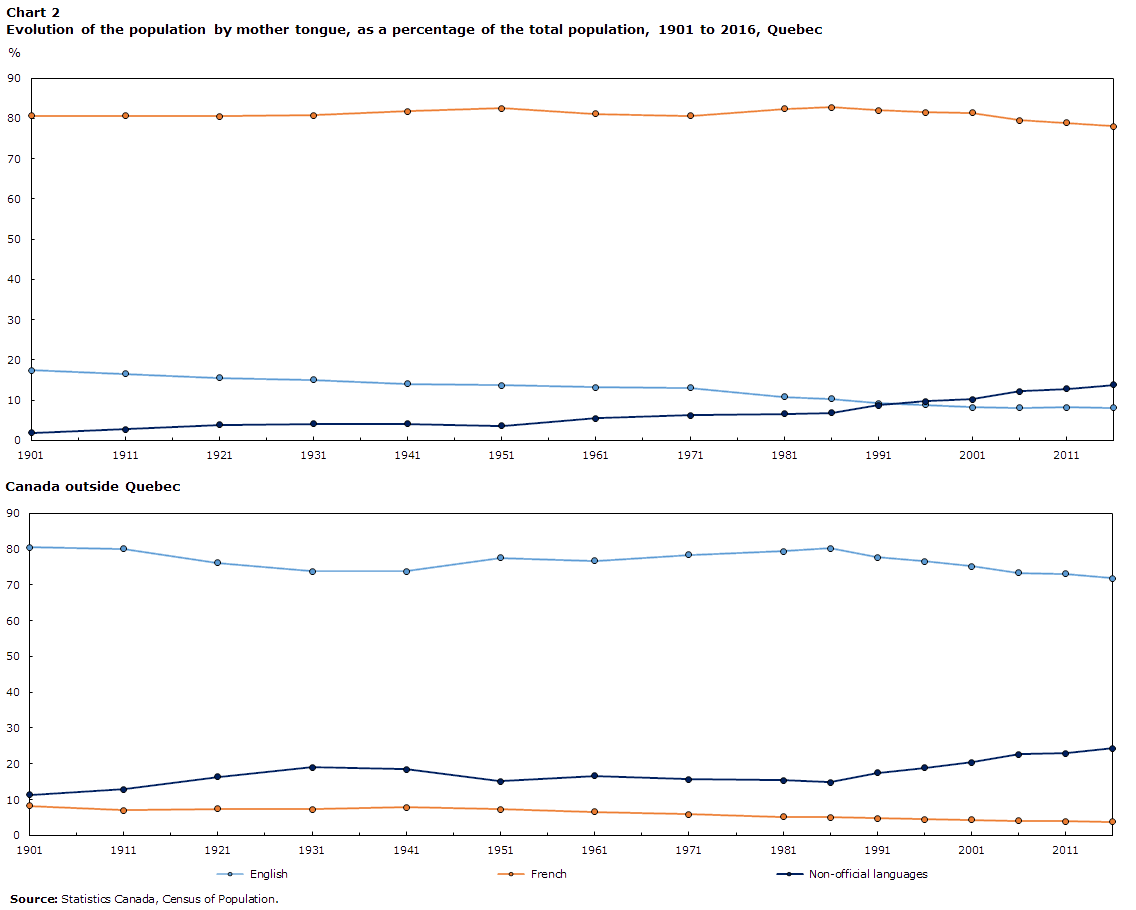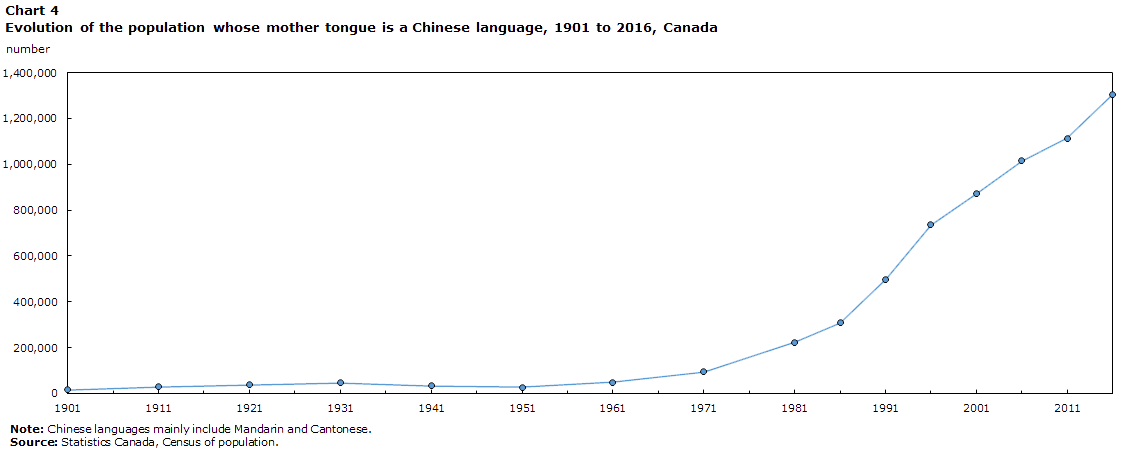The evolution of language populations in Canada, by mother tongue, from 1901 to 2016
Archived Content
Information identified as archived is provided for reference, research or recordkeeping purposes. It is not subject to the Government of Canada Web Standards and has not been altered or updated since it was archived. Please "contact us" to request a format other than those available.

At the beginning of the 20th century, the mother tongue of most Canadians was either French or English. In 1901, about one-tenth of the population declared an Aboriginal language or an immigrant language as their mother tongue. The concept of mother tongue was not defined in the Canadian census until 1941, when it was defined as the first language learned at home in childhood and still understood.
Over the next 115 years, Canada's linguistic profile became considerably more diverse. The share of Canadians with French as a mother tongue declined, while the proportion of Canadians whose mother tongue is neither French nor English increased in line with various waves of immigration over time.
This month's issue of Canadian Megatrends tracks the evolution of the Canadian population's composition by mother tongue from 1901 to 2016.
Changes in the three major linguistic groups in Canada
The share of people whose mother tongue is English varied slightly from 1901 to 2016. It was around 60% over this period, ranging from a high of 62.3% in 1911 to a low of 56.5% in 1941. Since 1986, however, this share has been gradually decreasing. In 2016, people with English as their mother tongue accounted for 57.0% of the total Canadian population, compared with 62.2% in 1986.
The share of the population whose mother tongue is English and that of the overall population whose mother tongue is a non-official language evolved in opposite directions; when the share of people whose mother tongue is English increased, the share of those whose with a non-official language as a mother tongue decreased, and vice versa.
From 1901 to 1986, the share of the population with a non-official language as a mother tongue varied between 8% and 13%, reflecting international migratory flows. Without sustained migration, this population tended to decline, as it did from 1931 to 1951, during the 1970s and in the first half of the 1980s.
Since the early 1990s, however, the number of immigrants admitted to Canada has been consistently high—between around 200,000 and 250,000 per year. As a result, in 2016, 22.0% of the total population declared a language other than English and French as a mother tongue. This population is highly heterogeneous in terms of language. In the 2016 Census, more than 130 immigrant languages were recorded.
In the 2016 Census, 213,225 people reported an Aboriginal language as a mother tongue, accounting for 0.6% of the population. Although their enumeration was certainly not complete, the 1901 Census counted close to 77,000 people whose mother tongue is an Aboriginal language, representing 1.4% of the population.
Aboriginal languages in Canada have been evolving over generations. Many Aboriginal languages are unique to Canada, spoken nowhere else in the world. Several Aboriginal languages are now "endangered" with few people reporting speaking them, while a few others are considered "viable" in the long term. Past events have significantly harmed the vitality of Aboriginal languages in Canada. These include the implementation of the residential school system, under which generations of Aboriginal children were not permitted to speak their Aboriginal mother tongues.
The relative share of the population whose mother tongue is French in Canada was also affected by fluctuations in the size of population with a mother tongue other than English or French. The two great waves of immigration in the early 20th century and after the Second World War led to a decrease in the proportion of people whose mother tongue is French. Despite the impact of immigration, people who declared French as their mother tongue maintained their population levels into the 1950s because of high fertility rates. Since the 1951 Census, this population's share has steadily decreased in Canada.
In 1941, 29.3% of the Canadian population declared French as their mother tongue. This was the highest level since 1901. By 2016, this proportion had fallen to 21.0%, a decrease of more than eight percentage points over a 75-year period.

Description of Chart 1. Evolution of the population by mother tongue, as a percentage of the total population, 1901 to 2016, Canada
| English | French | Non-official languages | |
|---|---|---|---|
| 1901 | 61.0 | 30.5 | 8.4 |
| 1911 | 62.3 | 27.7 | 10.1 |
| 1921 | 60.0 | 27.0 | 13.1 |
| 1931 | 57.5 | 27.6 | 14.9 |
| 1941 | 56.5 | 29.2 | 14.3 |
| 1951 | 59.1 | 29.0 | 11.8 |
| 1961 | 58.5 | 28.1 | 13.5 |
| 1971 | 60.2 | 26.8 | 13.0 |
| 1981 | 61.2 | 25.6 | 13.1 |
| 1986 | 62.2 | 25.1 | 12.7 |
| 1991 | 60.4 | 24.3 | 15.3 |
| 1996 | 59.8 | 23.5 | 16.6 |
| 2001 | 59.1 | 22.9 | 18.0 |
| 2006 | 57.8 | 22.1 | 20.1 |
| 2011 | 57.8 | 21.7 | 20.6 |
| 2016 | 57.2 | 20.9 | 21.9 |
| Source: Statistics Canada, Census of the Population. | |||
Linguistic duality
Canada has two official languages: French and English. In New Brunswick, French an English are the two official languages. In Quebec, French is the sole official language and is spoken by the majority of the population, although English is fairly common in the Montréal region. In the rest of Canada, provinces and territories have adopted their own policies and legislation to protect languages. The Northwest Territories recognize nine Aboriginal languages alongside English and French through its Official Languages Act, while Inuit languages (Inuktitut and Inuinnaqtun), English and French are the official languages of Nunavut.
There are some similarities in the size and evolution of mother-tongue populations in Quebec and across the rest of the country. The majority language groups (French in Quebec, English in the rest of Canada) have maintained a relatively stable population share from 1901 to 2016.
In Quebec, the share of people with French as their mother tongue was around 80% from 1901 to 2001, and then declined, reaching 78.0% in 2016. In the rest of Canada, the share of people with English as their mother tongue varied more over time, fluctuating between 74% and 80% before 1986, and decreasing steadily since. In 2016, the share was 71.8%.
The evolution of official language minority populations has followed a different path than that of majority language populations. The share of Quebec residents whose mother tongue is English has declined since 1901, as has the share of people whose mother tongue is French in the rest of Canada.
The percentage of Quebec's English-mother-tongue population fell by more than half from 1901 to 2016, from 17.4% to 8.1%. In 1901, the French-mother-tongue minority outside Quebec represented 8.2% of the total population outside that province, versus 3.8% in 2016. This was a decline of more than half over the 115-year period.

Description of Chart 2. Evolution of the population by mother tongue, as a percentage of the total population, 1901 to 2016, Quebec and Canada outside Quebec
| English | French | Non-official languages | |
|---|---|---|---|
| Quebec | |||
| 1901 | 17.4 | 80.6 | 1.9 |
| 1911 | 16.5 | 80.6 | 2.8 |
| 1921 | 15.6 | 80.5 | 3.9 |
| 1931 | 15.1 | 80.7 | 4.1 |
| 1941 | 14.1 | 81.8 | 4.1 |
| 1951 | 13.8 | 82.5 | 3.7 |
| 1961 | 13.3 | 81.2 | 5.6 |
| 1971 | 13.1 | 80.6 | 6.2 |
| 1981 | 10.9 | 82.4 | 6.7 |
| 1986 | 10.3 | 82.8 | 6.9 |
| 1991 | 9.2 | 82.0 | 8.8 |
| 1996 | 8.8 | 81.5 | 9.7 |
| 2001 | 8.3 | 81.4 | 10.3 |
| 2006 | 8.2 | 79.6 | 12.3 |
| 2011 | 8.3 | 78.9 | 12.8 |
| 2016 | 8.8 | 77.4 | 13.7 |
| Canada outside Quebec | |||
| 1901 | 80.4 | 8.2 | 11.3 |
| 1911 | 80.1 | 7.0 | 12.9 |
| 1921 | 76.2 | 7.4 | 16.4 |
| 1931 | 73.7 | 7.3 | 19.0 |
| 1941 | 73.8 | 7.8 | 18.4 |
| 1951 | 77.6 | 7.3 | 15.2 |
| 1961 | 76.8 | 6.6 | 16.7 |
| 1971 | 78.5 | 5.9 | 15.6 |
| 1981 | 79.3 | 5.2 | 15.4 |
| 1986 | 80.2 | 5.0 | 14.8 |
| 1991 | 77.7 | 4.8 | 17.5 |
| 1996 | 76.6 | 4.5 | 18.9 |
| 2001 | 75.2 | 4.4 | 20.4 |
| 2006 | 73.3 | 4.1 | 22.6 |
| 2011 | 73.1 | 4.0 | 23.0 |
| 2016 | 71.8 | 3.8 | 24.4 |
| Source: Statistics Canada, Census of Population. | |||
Linguistic diversity in Canada
In the last 115 years, the linguistic composition of the population with a mother tongue other than French, English or an Aboriginal language varied considerably in Canada. In 1901, two immigrant language groups accounted for most of this population: Celtic languages (mainly Irish Gaelic and Scottish Gaelic) and German. The Celtic language population declined rapidly in the following decades, both in terms of absolute numbers and population share.
From 1901 to 1941, the German-language population was by far the largest among immigrant-language populations. From 1901 to 1981, most non-official languages in Canada were European. Ukrainian, Russian and Polish increased mainly during the first decades of the 20th century, as settlements spread across the Prairies. Other European languages (German, Italian, Greek and Dutch, among others) made rapid gains following the Second World War.

Description of Chart 3. Evolution of the total population, by selected immigrant languages from early settlements, 1901 to 2016, Canada
| Dutch | German | Greek | Italian | Polish | Russian | Ukrainian | |
|---|---|---|---|---|---|---|---|
| 1901 | F | 152,455 | F | 6,245 | 5,700 | 15,240 | 7,460 |
| 1911 | 5,455 | 222,370 | F | 40,925 | 40,110 | 42,185 | 57,520 |
| 1921 | 34,005 | 275,375 | F | 53,410 | 59,000 | 57,720 | 131,120 |
| 1931 | 44,580 | 368,850 | 7,350 | 85,520 | 118,600 | 50,760 | 252,800 |
| 1941 | 67,770 | 331,660 | 8,745 | 80,260 | 128,710 | 52,435 | 313,275 |
| 1951 | 100,560 | 329,305 | 8,035 | 92,240 | 129,235 | 39,225 | 352,325 |
| 1961 | 184,480 | 563,710 | 40,455 | 339,625 | 161,720 | 42,900 | 361,500 |
| 1971 | 171,275 | 558,965 | 103,730 | 538,765 | 136,540 | 31,955 | 309,890 |
| 1981 | 158,470 | 515,510 | 123,230 | 531,290 | 127,400 | 31,355 | 285,115 |
| 1991 | 139,035 | 466,245 | 126,205 | 510,995 | 189,815 | 35,305 | 187,015 |
| 1996 | 139,475 | 470,500 | 128,085 | 514,415 | 222,355 | 59,630 | 174,830 |
| 2001 | 133,040 | 455,545 | 126,370 | 493,990 | 215,010 | 96,910 | 157,385 |
| 2006 | 133,240 | 466,655 | 123,575 | 476,905 | 217,605 | 136,230 | 141,805 |
| 2011 | 116,285 | 430,055 | 117,890 | 437,725 | 201,240 | 169,950 | 120,265 |
| 2016 | 107,204 | 412,257 | 117,787 | 413,766 | 194,102 | 196,813 | 113,229 |
|
F too unreliable to be published Note: Data for 1901 on people who declared Dutch as their mother tongue are too unreliable to be published. Data for 1901, 1911 and 1921 on people who declared Greek as their mother tongue are too unreliable to be published. Source: Statistics Canada, Census of Population. | |||||||
The composition of immigrant languages changed markedly starting in the 1970s and 1980s. Before the Second World War, parts of the Canadian population already declared a few non-European languages (Chinese, Japanese and Arabic) as their mother tongue. However, changes to immigration laws and rules in the 1960s contributed to a rapid rise in immigration from Asia, the Middle East, Latin America, the West Indies and Africa.
These changes brought about an increase in language diversity. As a result, the number of people who declared Chinese as their mother tongue jumped from less than 100,000 in 1971 to more than 1.3 million in 2016. Since the mid-1980s, many other language groups have experienced similar changes. These populations have grown steadily, as a result of immigration trends over the period.

Description of Chart 4. Evolution of the population whose mother tongue is a Chinese language, 1901 to 2016, Canada
| Chinese | |
|---|---|
| 1901 | 16,470 |
| 1911 | 28,410 |
| 1921 | 38,450 |
| 1931 | 46,110 |
| 1941 | 33,500 |
| 1951 | 28,285 |
| 1961 | 49,100 |
| 1971 | 95,915 |
| 1981 | 224,135 |
| 1986 | 308,515 |
| 1991 | 498,845 |
| 1996 | 736,010 |
| 2001 | 872400 |
| 2006 | 1,015,230 |
| 2011 | 1,112,610 |
| 2016 | 1,312,859 |
Note: Chinese languages comprise Cantonese, Hakka, Mandarin, Min Dong, Min Nan (Chaochow, Teochow, Fukien and Taiwanese), Wu (Shanghainese) and other Chinese languages not otherwise specified or indicated elsewhere. Source: Statistics Canada, Census of population. | |

Description of Chart 5. Evolution of the total population, by selected immigrant languages from recent settlements, 1971 to 2016, Canada
| Persian | Punjabi | Urdu | Vietnamese | Tagalog | Spanish | Arabic | Portuguese | |
|---|---|---|---|---|---|---|---|---|
| 1971 | .. | .. | .. | .. | .. | 23,945 | 28,520 | 85,840 |
| 1981 | .. | 53,770 | 11,925 | 28,380 | .. | 70,150 | 49,645 | 164,615 |
| 1986 | 13,820 | 80,630 | 17,770 | 51,795 | 68,670 | 104,150 | 57,045 | 180,760 |
| 1991 | 40,625 | 136,460 | 24,900 | 78,565 | 99,715 | 177,425 | 107,750 | 212,090 |
| 1996 | 62,380 | 214,535 | 43,725 | 111,910 | 158,205 | 228,575 | 166,155 | 222,875 |
| 2001 | 96,510 | 284,750 | 86,805 | 126,760 | 199,770 | 260,785 | 220,535 | 222,855 |
| 2006 | 138,075 | 382,590 | 156,415 | 146,410 | 266,445 | 362,120 | 286,790 | 229,285 |
| 2011 | 177,010 | 459,990 | 194,100 | 153,355 | 384,055 | 439,110 | 374,415 | 225,530 |
| 2016 | 225,792 | 544,761 | 243,431 | 167,785 | 512,167 | 497,496 | 488,189 | 239,030 |
|
.. not available for a specific reference period Note: Data for 1971 on Persian, Punjabi, Urdu, Vietnamese and Tagalog languages are not available. Data for 1981 on Persian and Tagalog languages are not available. Source: Statistics Canada, Census of Population. |
||||||||
Definitions
- Mother tongue
- First language learned at home in childhood and still understood at the time of the census. For the definition used in the censuses at the beginning of the 20th century, see Houle et Cambron-Prémont (2015).
- Aboriginal languages
- Languages native to the North American continent. These include Cree languages, Inuktitut and Dene, among others.
- Immigrant languages
- Languages—other than French, English and Aboriginal languages—whose presence in Canada is originally due to immigration. These include German, Chinese, Ukrainian, Spanish, Italian and Punjabi, among others.
- Non-official languages
- Aboriginal and immigrant languages combined.
References
Houle, René and Amélie Cambron-Prémont. 2015. "Les concepts et les questions posées sur les langues aux recensements canadiens de 1901 à 1961." Cahiers québécois de démographie, vol. 44, no. 2, pages 291 to 310 (French only).
Houle, René. 2012. "Immigrant languages in Canada," Census in Brief, Statistics Canada, catalogue no. 98-314-X.
Lachapelle, Réjean and Jacques Henripin. 1980. The demolinguistic situation in Canada: Past trends and future prospects. Montréal, Institute for Research on Public Policy.
Lachapelle, Réjean and Jean-François Lepage. 2010. Languages in Canada: 2006 Census. Ottawa, Canadian Heritage and Statistics Canada.
Contact information
For more information, or to enquire about the concepts, methods or data quality of this release, contact René Houle (rene.houle@canada.ca; 613-854-8473), Centre for Ethnocultural, Language and Immigration Statistics.
- Date modified:
